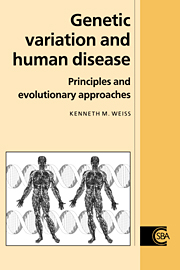Book contents
- Frontmatter
- Contents
- Frontispiece
- Preface: what is this book all about?
- Notational conventions used in this book
- List of abbreviations
- Part I Genes and their expression
- Part II Introduction to genetic epidemiology: inference from observational data
- 5 Segregation analysis: discrete traits in families
- 6 Segregation analysis: quantitative traits in families
- 7 Linkage analysis: finding and mapping genes for qualitative traits
- 8 Linkage analysis: finding and mapping genes for quantitative traits
- Part III Evolution: the time dimension in populations
- Part IV Modification of the inherited genotype: the time dimension in individuals
- Afterwords: towards a unified general model
- References
- Index
7 - Linkage analysis: finding and mapping genes for qualitative traits
from Part II - Introduction to genetic epidemiology: inference from observational data
Published online by Cambridge University Press: 05 June 2012
- Frontmatter
- Contents
- Frontispiece
- Preface: what is this book all about?
- Notational conventions used in this book
- List of abbreviations
- Part I Genes and their expression
- Part II Introduction to genetic epidemiology: inference from observational data
- 5 Segregation analysis: discrete traits in families
- 6 Segregation analysis: quantitative traits in families
- 7 Linkage analysis: finding and mapping genes for qualitative traits
- 8 Linkage analysis: finding and mapping genes for quantitative traits
- Part III Evolution: the time dimension in populations
- Part IV Modification of the inherited genotype: the time dimension in individuals
- Afterwords: towards a unified general model
- References
- Index
Summary
Segregation analysis provides evidence that a disease has a genetic causation, but this is only the beginning, since our real goal is to find the genes involved. An important objective is to map the genes to their chromosomal location.
Modern molecular biology provides a rapidly increasing repertoire of methods for the physical mapping of genes. Genes can be isolated and cloned using many different techniques (e.g. see Appendix 1.2), and variants can be related to function and physiology both in experimental systems and in natural settings. Physical mapping will probably become the overwhelming method of choice for identifying human genes.
That day is not yet here, however, and we currently still rely on statistical epidemiological methods. In some cases simple association studies will suffice, but usually we rely on linkage mapping methods. These take advantage of the fact that evolution has produced a genome consisting of genes concatenated on chromosomes. Probably we owe this arrangement to evolution by gene duplication and to the need to coordinate regulation {De Duve, 1991}. In any case, linkage mapping methods search for association relationships that are due to linkage, between genes that have already been mapped and genetically controlled phenotypes whose genes we have not yet identified. The bible on linkage mapping methods is the text by Ott {1991} {Conneally and Rivas, 1980; Lathrop and Lalouel, 1984; White and Lalouel, 1987}. These methods are so powerful that scarcely a week passes without their being used to map some new gene.
- Type
- Chapter
- Information
- Genetic Variation and Human DiseasePrinciples and Evolutionary Approaches, pp. 117 - 136Publisher: Cambridge University PressPrint publication year: 1993
- 1
- Cited by



